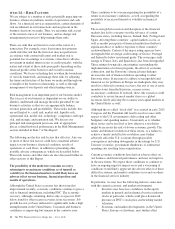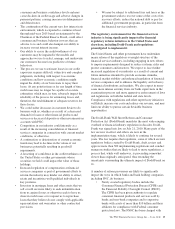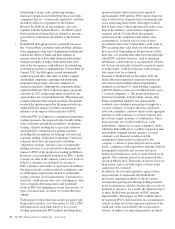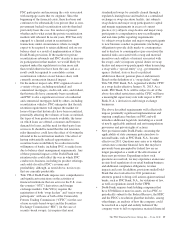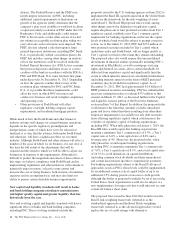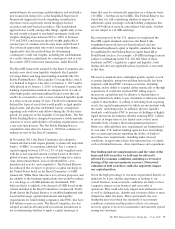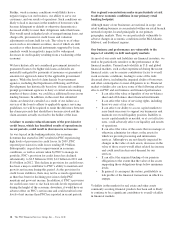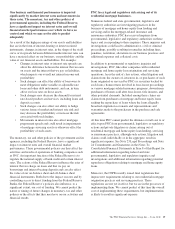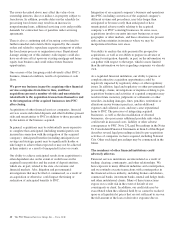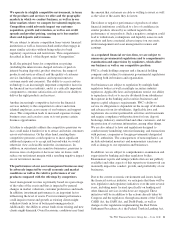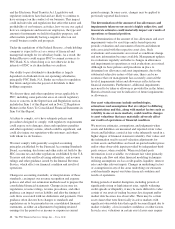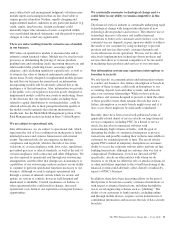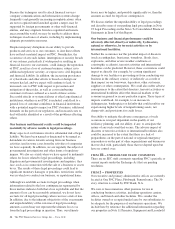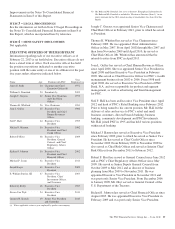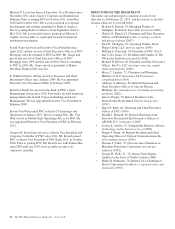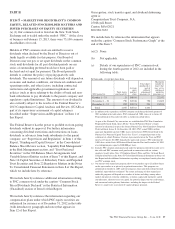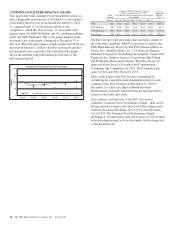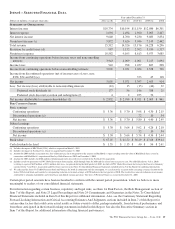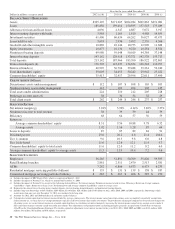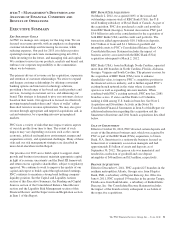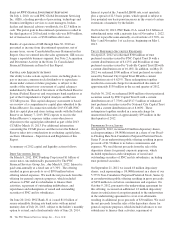PNC Bank 2012 Annual Report Download - page 41
Download and view the complete annual report
Please find page 41 of the 2012 PNC Bank annual report below. You can navigate through the pages in the report by either clicking on the pages listed below, or by using the keyword search tool below to find specific information within the annual report.and the Electronic Fund Transfer Act. Legislative and
regulatory initiatives have had and are likely to continue to
have an impact on the conduct of our business. This impact
could include rules and regulations that affect the nature and
profitability of our business activities, how we use our capital,
how we compensate and incent our employees, the type and
amount of instruments we hold for liquidity purposes, and
other matters potentially having a negative effect on our
overall business results and prospects.
Under the regulations of the Federal Reserve, a bank holding
company is expected to act as a source of financial and
managerial strength for its subsidiary banks. As a result, the
Federal Reserve could require PNC to commit resources to
PNC Bank, N.A. when doing so is not otherwise in the
interests of PNC or its shareholders or creditors.
Our ability to pay dividends to shareholders is largely
dependent on dividends from our operating subsidiaries,
principally PNC Bank, N.A. Banks are subject to regulation
that limits and governs the payout of dividends to their
holding companies.
We discuss these and other regulatory issues applicable to
PNC, including some particular areas of current regulatory
focus or concern, in the Supervision and Regulation section
included in Item 1 of this Report and in Note 22 Regulatory
Matters in the Notes To Consolidated Financial Statements in
Item 8 of this Report.
A failure to comply, or to have adequate policies and
procedures designed to comply, with regulatory requirements
could expose us to damages, fines and regulatory penalties
and other regulatory actions, which could be significant, and
could also injure our reputation with customers and others
with whom we do business.
We must comply with generally accepted accounting
principles established by the Financial Accounting Standards
Board, accounting, disclosure and other rules set forth by the
SEC, income tax and other regulations established by the U.S.
Treasury and state and local taxing authorities, and revenue
rulings and other guidance issued by the Internal Revenue
Service, which affect our financial condition and results of
operations.
Changes in accounting standards, or interpretations of those
standards, can impact our revenue recognition and expense
policies and affect our estimation methods used to prepare the
consolidated financial statements. Changes in income tax
regulations, revenue rulings, revenue procedures, and other
guidance can impact our tax liability and alter the timing of
cash flows associated with tax deductions and payments. New
guidance often dictates how changes to standards and
regulations are to be presented in our consolidated financial
statements, as either an adjustment to beginning retained
earnings for the period or as income or expense in current
period earnings. In some cases, changes may be applied to
previously reported disclosures.
The determination of the amount of loss allowances and
impairments taken on our assets is highly subjective, and
inaccurate estimates could materially impact our results of
operations or financial position.
The determination of the amount of loss allowances and asset
impairments varies by asset type and is based upon our
periodic evaluation and assessment of known and inherent
risks associated with the respective asset class. Such
evaluations and assessments are revised as conditions change
and new information becomes available. Management updates
its evaluations regularly and reflects changes in allowances
and impairments in operations as such evaluations are revised.
Although we have policies and procedures in place to
determine loss allowance and asset impairments, due to the
substantial subjective nature of this area, there can be no
assurance that our management has accurately assessed the
level of impairments taken and allowances reflected in our
financial statements. Furthermore, additional impairments
may need to be taken or allowances provided for in the future.
Historical trends may not be indicative of future impairments
or allowances.
Our asset valuation may include methodologies,
estimations and assumptions that are subject to differing
interpretations and this, along with market factors such as
volatility in one or more markets, could result in changes
to asset valuations that may materially adversely affect
our results of operations or financial condition.
We must use estimates, assumptions, and judgments when
assets and liabilities are measured and reported at fair value.
Assets and liabilities carried at fair value inherently result in a
higher degree of financial statement volatility. Fair values and
the information used to record valuation adjustments for
certain assets and liabilities are based on quoted market prices
and/or other observable inputs provided by independent third-
party sources, when available. When such third-party
information is not available, we estimate fair value primarily
by using cash flow and other financial modeling techniques
utilizing assumptions such as credit quality, liquidity, interest
rates and other relevant inputs. Changes in underlying factors
or assumptions in any of the areas underlying our estimates
could materially impact our future financial condition and
results of operations.
During periods of market disruption, including periods of
significantly rising or high interest rates, rapidly widening
credit spreads or illiquidity, it may be more difficult to value
certain of our assets if trading becomes less frequent and/or
market data becomes less observable. There may be certain
asset classes that were historically in active markets with
significant observable data that rapidly become illiquid due to
market volatility, a loss in market confidence or other factors.
In such cases, valuations in certain asset classes may require
22 The PNC Financial Services Group, Inc. – Form 10-K


